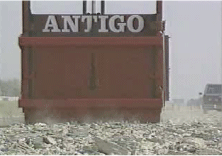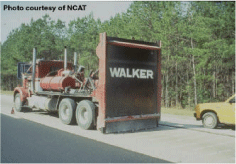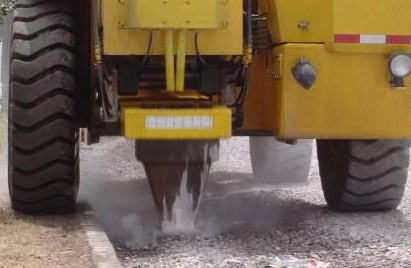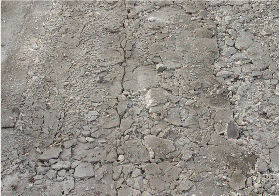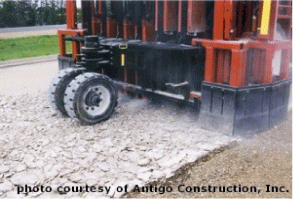Section 9: Reusing Rigid Pavements as Base
Acknowledgement: Content of this section is made available from the University of Washington, Pavement Tools Consortium.
Various procedures can be used to utilize poor performing or functionally inadequate rigid (Portland cement concrete [PCC]) pavements into a subbase or base for a bituminous surfaced structure. The object is to reduce the size of “free-moving” PCC slabs to minimize differential movement at existing cracks, joints, and punchouts. This will, in turn, reduce the occurrence and severity of reflective cracking through the newly applied bituminous surface. Three processes are generally recognized for reusing rigid pavements: break and seat, crack and seat, and rubblizing. These procedures may not be well-suited for locations where a thin, old slab rests directly on saturated subgrade (non free-draining) since the slab will often tend to rock under the impact of pavement breakers and may not reduce down to desirable sized particles. If free moisture exists in the structure, placing an edge drain system prior to reducing the PCC slabs may be effective in improving the stability of the slab enough to make these reduction methods possible.
Anchor: #i10085179.1 Break and Seat
This process may be used to reduce the size of jointed reinforced concrete pavement (JRCP) to pieces on the order of about 1 to 2 ft.2 by repeatedly dropping a large weight. The objective is to retain some slab action, but reinforcing steel must be ruptured or the bond broken. Typically, a drop hammer or “guillotine” type device is used as shown in Figure 7-4 and Figure 7-5. Broken PCC is then seated into the foundation using several passes of a 35 to 50 ton pneumatic roller.
Figure 7-4. Drop hammer breaking slab for break and seat operations. © Copyright 2006 University of Washington
Figure 7-5. Drop hammer “breaking” slab for “break and seat.” © Copyright 2006 University of Washington
Anchor: #i10086449.2 Crack and Seat
This process may be used to reduce jointed plain concrete pavement (JPCP) to pieces 1 to 3 ft.2 in size. Equipment similar to that used for break and seat is used to reduce the slab. Some slab action is retained. Broken PCC is then seated into the foundation using several passes of a 35 to 50 ton pneumatic roller.
Anchor: #i10086959.3 Rubblizing
This process will completely fracture any type of PCC slab into pieces smaller than 1 ft.2 and is very effective in breaking the bond of any reinforcing steel to the slab fragments. The slab is reduced to a high strength granular base that is not susceptible to transmitting reflective cracking through the HMA overlay. The fractured layer is typically compacted using a 10 ton vibratory roller. This is the preferred process for reducing JRCP and CRCP pavements. Rubblizing is typically done with one of the following two pieces of equipment:
9.3.1 Resonant Pavement Breaker
This equipment strikes the rigid pavement at low amplitude with a small plate at the resonant frequency of the slab (usually about 44 Hz) causing the slab to break apart as shown in Figure 7-6. Usually, it takes about 14 to 18 passes for a resonant pavement breaker to rubblize an entire 3.6 m (12 ft.) lane (NCAT, 2001). Daily production rate is estimated to be about 6,000 yd.2/day. Figure 7-7 depicts broken pavement after using the resonant pavement breaker.
Figure 7-6. Resonant Pavement Breaker. © Copyright 2006 University of Washington
Figure 7-7. Rubblized pavement texture following resonant pavement breaking. © Copyright 2006 University of Washington
Anchor: #i10087749.4 Multi-head Breaker (MHB)
This equipment uses a series of independently controlled high amplitude drop hammers to smash the slab. Typically, there are between 12 and 16 hammers, each weighing between 1,000 to 1,500 lbs. Hammers can be dropped from variable heights 1 to 5 ft. to create impact energies between 2,000 to 12,000 ft.-lbs. Hammers cycle at a rate of 30 to 35 impacts per minute. MHBs can rubblize an entire lane up to 13 ft. in a single pass (Antigo Construction, 2001). Figure 7-8 shows a typical multi-head breaker.
Figure 7-8. Multi-head Pavement Rubblizer. © Copyright 2006 University of Washington
